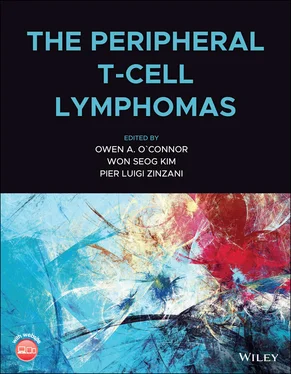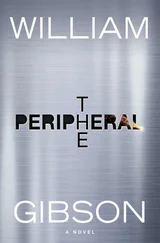Protein Arginine Methyltransferases Inhibitors
Protein arginine methyltransferases inhibitors (PRMTs) catalyze the monomethylation or dimethylation of arginine residues on histone and non‐histone proteins. A total of nine human PRMTs are known to exist, although PRMT5 seems to be the most relevant to oncogenesis. PRMT5 is a type II PRMT that specifically catalyzes the symmetrical dimethylation of arginine residues located on the H3 or H4 proteins, resulting in gene silencing [118]. PRMT5 might also have a role in the development of TCLs. Similar to EBV‐transformed lymphoma, PRMT5 expression is upregulated in human T‐cell lymphotropic virus type 1 (HTLV)‐transformed ATLL, and PRMT5 inhibition was shown to have selective cytotoxic effects on HTLV+ lymphoma cells [130]. Overexpression of PRMT5 in ATLL seems to interact with oncogenic CCND1, MYC, and NOTCH1 in driving lymphomagenesis and might also directly silence p53 [131]. No PRMT inhibitors have thus far received FDA approval, and the first clinical trial designed to investigate a PRMT5 inhibitor (GSK3326595) commenced in 2016 for patients with solid tumors or non‐Hodgkin lymphoma (NCT02783300). Despite this lack of clinical evidence, a growing body of data from preclinical studies has demonstrated a potentially important role of this class of drug, specifically for the treatment of lymphoid malignancies. Activating mutations in PRMT5 have not been reported in patients with lymphoma, although PRMT5 is overexpressed in different subtypes and might potentially serve as a biomarker.
Combination Therapies Involving Epigenetic Targeting Agents
One of the more exciting areas in PTCL research involves the development of combination therapies that target, either in part or in unison, some of the dysregulated epigenetic biology discussed above. While these experiences are discussed in more detail in other chapters (and is summarized here in Table 3.3), it is becoming increasingly clear that drugs targeting the epigenome may well form the cornerstone of future PTCL‐directed combination therapies. As this experience evolves, it will be incumbent on the scientific community to decipher, as best it can, the relationships between clinical activity of these combinations and the underlying epigenetic biology. In this fashion, it will be likely that very targeted epigenetic predicated platforms could emerge in a subtype directed manner.
As discussed above, there are many lines of evidence that suggest that the T‐cell malignancies harbor many lesions that underscore its gross epigenetic dysregulation. In addition, it is clear that efficacy of epigenetic‐based monotherapies, which exhibit a clear lineage specific selectivity in the TCL, is only the first step in trying to leverage our growing understanding of these diseases in a treatment focused fashion in is limited. Combinations of drugs predicated on a HDAC inhibitor backbone appear to improve the efficacy of these agents, as demonstrated in phase I and phase II trials investigating HDAC or DNMT inhibitors. The combination of epigenetic modulating agents with immunotherapy provides perhaps the most exciting avenue for future research. Histone modification typically results in closed chromatin states at the MHC class II promoters, and in MCL and DLBCL cells this can be reversed by HDAC inhibition, thus enhancing antigen‐specific immune recognition and activation [137, 138]. In addition, DNMT inhibitors seem to increase sensitivity to immune‐checkpoint inhibition [139, 140]. Presently, a number of studies are systematically exploring the combination of immune checkpoint inhibitors with many of the agents descried above (romidepsin, decitabine, azacytidine, pralatrexate) as well as with various doublet combinations (ex 5‐azacytidine plus romidepsin, decitabine plus pralatrexate, and pralatrexate plus romidepsin). It is anticipated that, in the near future, these two‐ or three‐drug combinations will lead to a paradigm change in the disease, with a shift from the indiscriminate cytotoxic effects of chemotherapy, to likely immunoepigenetic‐based platforms.
Table 3.3 Combination agents targeting the T‐cell lymphoma epigenome.
| Drug combinations |
Class/Mechanism |
Disease |
Patients ( n ) |
ORR (%) |
CR (%) |
Median PFS (months) |
Median DOR (months) |
Refs. |
| Panobinostat/Bortezomib |
HDACi and proteasome inhibitor |
PTCL |
25 |
43 |
22 |
2.6 |
5.6 |
[132] |
| Romidepsin/Pralatrexate |
HDACi and folate antagonist |
PTCL/CTCL |
14 |
71 |
29 |
4.4 |
4.3 |
[133] |
| Romidepsin/Alisertib |
HDACi and Aurora A kinase inhibitor |
PTCL/CTCL |
3 |
33 |
33 |
> 6 |
nr |
[134] |
| Romidepsin/Duvelisib |
HDACi and PI3Kδ, −γ inhibitor |
PTCL/CTCL |
11 |
64 |
36 |
nr |
nr |
[135] |
| Romidepsin/Lenalidomide |
HDACi and immunomodulatory agent |
PTCL/CTCL |
10 |
50 |
0 |
13.5 weeks |
nr |
[136] |
| Romidepsin/Azacitidine |
AITL |
PTCL |
14 |
73 |
54 |
7.9 |
NR |
[52] |
CR, complete response; CTCL, cutaneous T‐cell lymphoma; DOR, duration of response; HDACi, histone deacetylase inhibitor; nr, not reported; NR, not reached; ORR, overall response rate; PFS, progression‐free survival; PTCL, peripheral T‐cell lymphoma.
Choi, J., Goh, G., Walradt, T. et al. (2015). Genomic landscape of cutaneous T cell lymphoma. Nat Genet 47(9):1011–1019.
Dunleavy, K., Wilson, W.H., Jaffe, E.S. (2007). Angioimmunoblastic T cell lymphoma: pathobiological insights and clinical implications. Curr Opin Hematol 14(4):348–353.
Iqbal, J., Wright, G., Wang, C. et al. (2014). Gene expression signatures delineate biological and prognostic subgroups in peripheral T‐cell lymphoma. Blood 123(19):2915–2923.
Pizzi, M., Margolskee, E., Inghirami, G. (2018). Pathogenesis of peripheral T cell lymphoma. Annu Rev Pathol 13(1):293–320.
Zain, J.M. (2019). Aggressive T‐cell lymphomas: 2019 updates on diagnosis, risk stratification, and management. Am J Hematol 94 (8):929–946.
1 1 Dickinson, M., Johnstone, R.W., and Prince, H.M. (2010). Histone deacetylase inhibitors: potential targets responsible for their anti‐cancer effect. Invest New Drugs 28 (Suppl 1): S3–S20.
2 2 Choi, J., Goh, G., Walradt, T. et al. (2015). Genomic landscape of cutaneous T cell lymphoma. Nat Genet 47 (9): 1011–1019.
3 3 da Silva Almeida, A.C., Abate, F., Khiabanian, H. et al. (2015). The mutational landscape of cutaneous T cell lymphoma and Sézary syndrome. Nat Genet 47 (12): 1465–1470.
4 4 Wang, L., Ni, X., Covington, K.R. et al. (2015). Genomic profiling of Sézary syndrome identifies alterations of keyT cell signaling and differentiation genes. Nat Genet 47 (12): 1426–1434.
5 5 Whittaker, S.J., Demierre, M.F., Kim, E.J. et al. (2010). Final results from a multicenter, international, pivotal study of romidepsin in refractory cutaneous T‐cell lymphoma. J Clin Oncol 28 (29): 4485–4491.
6 6 Iqbal, J., Wright, G., Wang, C. et al. (2014). Gene expression signatures delineate biological and prognostic subgroups in peripheral T‐cell lymphoma. Blood 123 (19): 2915–2923.
7 7 Sandell, R.F., Boddicker, R.L., and Feldman, A.L. (2017). Genetic landscape and classification of peripheral T cell lymphomas. Curr Oncol Rep 19 (4): 28.
8 8 Palomero, T., Couronné, L., Khiabanian, H. et al. (2014). Recurrent mutations in epigenetic regulators, RHOA and FYN kinase in peripheral T cell lymphomas. Nat Genet 46 (2): 166–170.
Читать дальше












